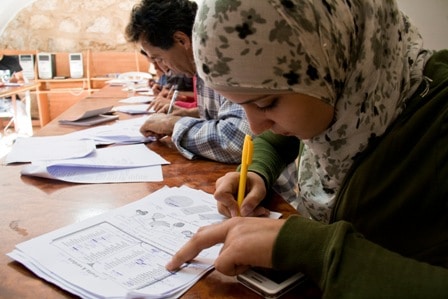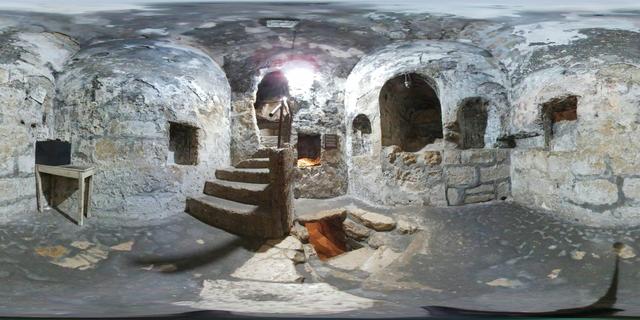 The Italian course at the village of Sabastiya is making good progress. The students, aged from 12 to 42, diligently attend the lessons held every Friday, taught by a member of the ATS pro Terra Sancta project.
Some are university students, some work in the mosaic centre, while others run the guesthouse. Here are a few of their stories:
Ahmad is 25 years old and has a degree in information technology. After having worked for a few years in Nablus he returned to Sabastiya. For the last six months he has been part of the ATS pro Terra Sancta project, co-ordinating activities for the children of the village. He explains: ‘I am very happy to be learning Italian, because I dream of becoming a guide for the tourists who come to Sabastiya. That is why I always accompany the Italian tour groups run by ATS pro Terra Sancta.’
Haya is 18 years old, and although she is shy she is also very determined. She studies English at the university, and would like to become a teacher. To the question ‘Why do you want to learn Italian?’, she answers: ‘I like languages, and I think that it is very important to learn as many as possible. On top of that, Italian is a beautiful language.’
Raed has come back to the village after living in Germany for six years. He is now 42 and works as an electrician in Sabastiya, where he also takes part in the ATS pro terra Sancta project. He says: ‘It is true that I work as an electrician and I should not really need to learn Italian, but actually I find it useful. We often get Italians at the site who are paying a visit to Sabastiya and want to find out more about the project that we are working on here. Now at least I can communicate with them a bit’.
Miriam, who works with ATS pro Terra Sancta and teaches the lessons, says she is happy with how her students are progressing: ‘They are highly motivated, they really want to learn the language and they always give it their best effort, even though it is difficult. I am really noticing the positive effects that the project is having on the village- these guys would probably have never had any job opportunities, the luckiest ones might have emigrated. Instead, now they have the chance to directly run the way their heritage, which is their greatest resource, is used.’
The Italian course being run in Sabastiya forms part of a wider program, financed by the Cariplo Foundation and carried out in co-operation with the Jericho Mosaic Center, which organises educational activities, especially for the women and young people of the village.
The Italian course at the village of Sabastiya is making good progress. The students, aged from 12 to 42, diligently attend the lessons held every Friday, taught by a member of the ATS pro Terra Sancta project.
Some are university students, some work in the mosaic centre, while others run the guesthouse. Here are a few of their stories:
Ahmad is 25 years old and has a degree in information technology. After having worked for a few years in Nablus he returned to Sabastiya. For the last six months he has been part of the ATS pro Terra Sancta project, co-ordinating activities for the children of the village. He explains: ‘I am very happy to be learning Italian, because I dream of becoming a guide for the tourists who come to Sabastiya. That is why I always accompany the Italian tour groups run by ATS pro Terra Sancta.’
Haya is 18 years old, and although she is shy she is also very determined. She studies English at the university, and would like to become a teacher. To the question ‘Why do you want to learn Italian?’, she answers: ‘I like languages, and I think that it is very important to learn as many as possible. On top of that, Italian is a beautiful language.’
Raed has come back to the village after living in Germany for six years. He is now 42 and works as an electrician in Sabastiya, where he also takes part in the ATS pro terra Sancta project. He says: ‘It is true that I work as an electrician and I should not really need to learn Italian, but actually I find it useful. We often get Italians at the site who are paying a visit to Sabastiya and want to find out more about the project that we are working on here. Now at least I can communicate with them a bit’.
Miriam, who works with ATS pro Terra Sancta and teaches the lessons, says she is happy with how her students are progressing: ‘They are highly motivated, they really want to learn the language and they always give it their best effort, even though it is difficult. I am really noticing the positive effects that the project is having on the village- these guys would probably have never had any job opportunities, the luckiest ones might have emigrated. Instead, now they have the chance to directly run the way their heritage, which is their greatest resource, is used.’
The Italian course being run in Sabastiya forms part of a wider program, financed by the Cariplo Foundation and carried out in co-operation with the Jericho Mosaic Center, which organises educational activities, especially for the women and young people of the village.
***
[nggallery id=138]























